Breasts come in all
shapes and sizes. They
change throughout your
life.
The breast is a
glandular organ that
produces milk after
pregnancy. Your breast
tissue extends beyond
the breast mound and
includes the area from
the middle of your chest
out to your armpit, up
to your collarbone and
down to your bra line.
Your chest muscles and
ribs are underneath the
breasts. There are no
muscles in your breasts.

Your breasts are
continually changing.
The major stages of
growth, development and
change occur during
puberty, pregnancy,
breast-feeding and
menopause.
Increased hormone
production during
puberty triggers the
growth of breast tissue.
Increasing age and
weight changes can
affect the shape, size
and feel of your
breasts.
During adolescence
breasts can often be
quite lumpy. Young
women's breasts are
usually dense and
fibrous because there is
more glandular tissue
than fatty tissue.
You may find that your
breasts feel more tender
and lumpy just before
your monthly period.
These cyclic changes are
normal and due to the
body's response to
changes in the level of
the female hormone,
oestrogen. The
tenderness and lumpiness
usually disappears after
your period. If you take
the contraceptive pill
you may experience extra
lumpiness or tenderness.
As you get older your
breasts become less
glandular and more
fatty. This tends to
make your breasts softer
and less lumpy, although
individual women vary
greatly and you may
retain some natural
lumpiness as you get
older.
You should look at and
feel your breasts
regularly so that you
become familiar with
what is normal for you.
If you are familiar with
the normal changes in
your breasts, you will
be better able to
identify changes that
are not usual for you.
The vast majority of breast
changes are not breast
cancer. If you find a change
in your breast or nipple it
might be caused by one of
the following:
Hormonal changesóHormones
may make your breasts feel
different at different times
during your menstrual cycle.
Your breasts may become
swollen, painful or tender.
FibroadenomasóFibroadenomas
are harmless lumps of fatty
or fibrous tissue. They
usually feel firm, smooth
and rubbery and may move
around in one area of your
breast. Although they are
common in younger women
(aged eighteen to thirty)
they can also be found in
women over thirty.
Fibroadenomas may become
tender in the days before
your period or grow bigger
during pregnancy. As with
all lumps, it is important
to have them checked by your
doctor.
CystsóCysts occur when fluid
becomes trapped in the
breast tissue. They may feel
like a soft or firm lump and
may be painful. Cysts are
common in women aged
thirty-five to fifty and in
women taking hormone
replacement therapy. You may
have a cyst, or a number of
cysts, without knowing it.
They do not usually require
treatment but may be drained
if they are painful or
troublesome. Although cysts
are harmless, any unusual
breast change should be
checked by your doctor.
Risk factors for breast
cancer can be classified
into two groups: those
for which we have strong
evidence and other risk
factors for which
evidence is not yet as
strong.
Risk
factorsóstrong evidence
-
Being a woman
The strongest risk
factor for breast
cancer is being a
woman. Breast cancer
can occur in men but
it is very rare.
-
Increasing age is
also a risk factor
Breast cancer
incidence increases
with age. It is rare
before the age of
twenty-five.
Seventy-five per
cent of breast
cancers occur in
women over fifty.
-
Women with a strong
family history of
breast cancer may
have an increased
chance of developing
breast cancer
The increase in risk
depends on the
number of relatives
affected, the age of
the relative(s) when
they developed
breast cancer and
whether they were on
one or both sides of
the family. Family
history accounts for
less than two per
cent of all breast
cancers. For more
information about
family history and
breast cancer visit
the
National Breast
Cancer Centre
website.
-
Previous history of
breast cancer or
certain breast
conditions
Women who have had
breast cancer in one
breast have a
greater risk of
developing it in the
other breast. There
are also certain
breast conditions (atypical
ductal hyperplasia,
ductal carcinoma in
situ,
lobular carcinoma in
situ) detected
through mammogram
that increase the
risk of breast
cancer.
Other
risk factorsóweaker
evidence
There are several other
factors that may affect
your risk of breast
cancer:
-
Beginning periods
before the age of
eleven and starting
menopause after
fifty-five have been
associated with an
increased risk of
breast cancer.
-
Having no children
or having a first
child after thirty
have both been
associated with
increased risk.
-
Women who are
currently taking the
contraceptive pill
have a slightly
increased risk of
breast cancer. Ten
years after coming
off the Pill the
risk is the same as
the general
population.
-
Having more than two
alcoholic drinks a
day also increases
risk.
-